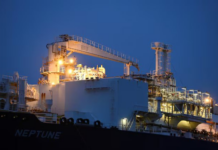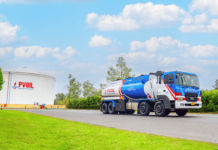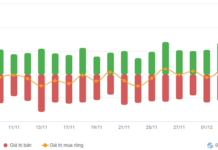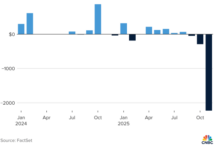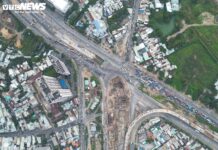Unraveling the Complexities: Vietnam’s Logistics Sector on the Rise
A recent report by the Ministry of Industry and Trade highlights significant developments in Vietnam’s logistics sector and transportation infrastructure over the past year (October 2023 to September 2024). During this period, numerous new policies were implemented to foster growth, particularly in the area of logistics, resulting in remarkable advancements in the country’s road infrastructure.
In 2023, Vietnam’s infrastructure quality index (primarily focusing on transportation) rose to 52nd out of 185 countries, a significant improvement from its 2019 ranking. However, the report identifies areas that require further attention, specifically addressing the need to enhance connectivity between ports and inland waterways to ensure a seamless transportation network.

Vietnam is focused on enhancing infrastructure and training human resources to boost the logistics industry.

The report also draws attention to the current limitations in high-speed road connections to ports. The Da Nang – Quang Ngai highway, for instance, is accessible from the Da Nang port via dedicated roads, urban roads, and national highways. However, many other ports, such as Ben Tien Sa in Da Nang, Ben Dung Quat II and Ben Nhon Hoi in Quy Nhon, and Ben My Thuy in Quang Tri, rely on urban roads, which restrict their operational capacity. While maintenance funds have been allocated, they only meet 40%-45% of the actual requirements.
The rail sector, though witnessing positive developments in 2023-2024, accounts for a minuscule market share in the overall transportation industry and has not received substantial investment. Connections between rail and ports or border gates remain inadequate. Notably, the rail sector’s market share is low, with passenger and cargo transportation accounting for approximately 0.2%-0.5% and 0.3%-0.8%, respectively.
The report emphasizes the need for increased investment in the rail sector, stating that it currently receives only 3%-4% of the total investment in the transportation industry. Additionally, there is a lack of non-budgetary funding sources for infrastructure development. Annual maintenance funds for rail infrastructure meet only about 40% of the requirement, and the sector faces a shortage of high-quality human resources to support future growth. The country’s rail industry also lags in technological advancement compared to regional and global peers.
Another challenge for Vietnam’s logistics sector lies in its inland waterway system. Despite its vast potential and high cargo turnover rate, this mode of transportation faces several obstacles. Inland waterways primarily handle low-value goods and have limited involvement in container transportation, even on high-potential routes like the Quang Ninh – Hai Phong – Hanoi – Viet Tri line, which connects to ports in the Hai Phong and Quang Ninh regions.
The current inland waterway infrastructure relies heavily on natural conditions, and while there are numerous ports and docks, most are small-scale with outdated loading and unloading equipment. Investments in waterways have lagged behind the master plan, and the lack of completeness and synchronization have created bottlenecks in key transportation routes. Administrative procedures related to investment and inland water transport development remain cumbersome, causing delays in the sector’s progress.
According to a World Bank (WB) study, reducing investment in road infrastructure by 2-3% would not significantly impact transportation efficiency. However, increasing investment in inland water transport by the same margin would drastically boost the sector’s growth and provide substantial economic benefits for Vietnam.
Other constraints include the lack of cargo collection warehouses, incompatible bulk cargo carriers, and insufficient channel dredging, hindering the navigation of larger vessels. Most domestic inland water transport enterprises, including those operating in coastal shipping, are small and medium-sized.
Emphasizing Human Resource Development
Human resource development in the logistics sector is a significant challenge for Vietnam. Citing a December 2023 report by the Ministry of Labor, Invalids, and Social Affairs, the demand for logistics personnel is increasing by 15% annually. However, only 35% of the logistics workforce has received specialized training. Additionally, 65% of surveyed logistics companies face difficulties in recruiting personnel with appropriate skills.
While collaborations between logistics enterprises and universities have helped increase the quantity of trained individuals, they have not kept pace with market demands. University curricula have also been criticized for failing to keep up with technological advancements and industry trends.
To propel the growth of Vietnam’s logistics sector, ministries, sectors, and localities must continue to streamline administrative procedures related to logistics, simplify specialized inspection procedures, and promptly address challenges faced by enterprises. By mobilizing resources and focusing on key transportation projects, along with enhancing the quality of infrastructure investments and logistics connectivity, Vietnam can create a powerful impetus for economic development across regions, economic zones, and domestic enterprises.
The Power of Waterways: Unlocking Domestic Logistics Cost-Effectiveness
Experts believe that leveraging the vast natural advantage of an intricate network of rivers, especially in the Mekong Delta and the Southeast region, can reduce logistics costs by boosting inland waterway transportation.
The Power of Planning: Unlocking the Development of South-East Vietnam
Effective provincial planning involves creating interconnected and cohesive strategies that enable each locality to thrive and showcase its unique strengths. The goal is to transform the Southeast region into the economic powerhouse of the country, with each province playing a pivotal role in this collective endeavor.


